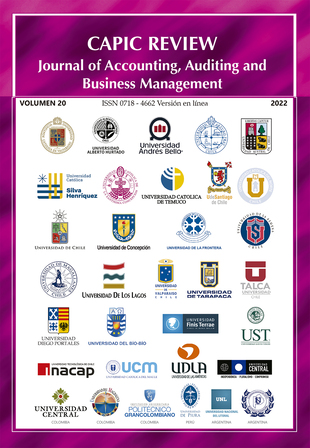Perceptions of controllers on management control systems in Peruvian companies
Published 2023-04-18
Keywords
- management control,
- perceptions of controllers,
- strategic planning,
- budgets,
- cost systems
How to Cite
Copyright (c) 2022 Julio Hernández-Pajares, Gino Vivanco Ruidías

This work is licensed under a Creative Commons Attribution-NonCommercial-ShareAlike 4.0 International License.
Abstract
Companies have evolved in the management control systems applied, which allow them to define strategic objectives and manage information through more advanced tools, such as data analytics and Enterprise Resource Planning (ERP). The objective of this study is to know the profile of both the controllers responsible for management control and the Peruvian companies that have such systems, and to describe the control systems and tools applied, as well as to know the controllers' perception of their importance.
This quantitative research of explanatory scope was carried out by means of a survey of controllers of Peruvian companies, which allowed a descriptive analysis of the control systems applied, as well as to know the controllers' perception of its importance and its factors.
The results indicate that controllers maintain the application of traditional control systems such as financial analysis, costs and budgets to a greater extent than systems based on strategic aspects such as the Balanced Scorecard (BSC). The implementation of data analytics and ERP is not a very developed practice and is an area for improvement. Companies with higher turnover, management control departments, strategic planning, and more experience present a higher valuation towards the importance of management control.
Downloads
References
- Almazán, J. L, Salvatorio, A. M., y Lee Kim, H. (2013). Balanced Scorecard (BSC).¿ una herramienta innovativa para las pymes mexicanas?. INCEPTUM, 8(15), 85-109.
- Angelakis, G., Theriou, N., y Floropoulos, I. (2010). Adoption and benefits of management accounting practices: Evidence from Greece and Finland. Advances in Accounting, 26(1), 87-96.
- Askarany, D., Yazdifar, H., y Askary, S. (2010). Supply chain management, activity-based costing and organisational factors. International Journal of Production Economics, 127(2), 238-248.
- Ayoup, H., Omar, N., y Abdul Rahman, I. K. (2012). Implementation of Balanced Scorecard (BSC) in a Malaysian GLC: Perceptions of middle managers. Asia-Pacific Management Accounting Journal, 7(2), 1-28.
- Awadallah, E. A., y Allam, A. (2015). A critique of the balanced scorecard as a performance measurement tool. International Journal of Business and Social Science, 6(7), 91-99.
- Azan, W. y Bollecker, M. (2011). Management control competencies and ERP: an empirical analysis in France. Journal of Modelling in Management, 6 (2), 178-199.
- Badem, A. C., Ergin, E., y Drury, C. (2013). Is standard costing still used? Evidence from Turkish automotive industry. International Business Research, 6(7), 79-90.
- Balios, D. (2021). The impact of Big Data on accounting and auditing. International Journal of Corporate Finance and Accounting, 8(1), 1-14.
- Basuony, M. A. (2014). The Balanced Scorecard in large firms and SMEs: A critique of the nature, value and application. Accounting and Finance Research, 3 (2), 14-22.
- Collier, N., Fishwick, F., y Floyd, S. W. (2004). Managerial involvement and perceptions of strategy process. Long range planning, 37(1), 67-83.
- Córdova, L. J. (2008). Aplicación del Balanced Scorecard como metodología de gestión en las mypes y pymes peruanas. Ingeniería Industrial, (26), 85-97.
- DeBusk, G. K., y Crabtree, A. D. (2006). Does the balanced scorecard improve performance? Management Accounting Quarterly, 8(1), 44.
- Dokulil, J., Popesko, B. y Kadalová, K. (2022). Factors with a Major Effect on the Budgetary Control Process – An Empirical Study From the Czech Republic. Amfiteatru Economic, 24(59), 236-250.
- Espinoza-Cruz, M., Espinoza, E., y Chumpitaz, (2021). Control interno y gestión empresarial de centros comerciales peruanos en tiempos de la actual pandemia. Contabilidad y Negocios, 16(31), 57-70.
- Fei, Z. Y., e Isa, C. R. (2010). Factors influencing activity-based costing success: A research framework. International Journal of Trade, Economics and Finance, 1(2), 144.
- García-Zapata, T., y Sotomayor, C. (2013). Modelo de mejora de la competitividad basada en indicadores críticos de gestión en las pequeñas empresas de servicios de mantenimiento de equipos pesados. Industrial Data, 16(1), 37-49.
- Gonçalves, T., y Gaio, C. (2021). The role of management accounting systems in global value strategies. Journal of Business Research, 124, 603-609.
- Gonzales, R., Wareham, J., y Serida, J. (2015). Measuring the impact of data warehouse and business intelligence on enterprise performance in Peru: A developing country. Journal of Global Information Technology Management, 18(3), 162-187.
- Granlund, M., y Malmi, T. (2002). Moderate impact of ERPS on management accounting: a lag or permanent outcome?. Management accounting research, 13(3), 299-321.
- Joshi, P. L. (2001). The international diffusion of new management accounting practices: the case of India. Journal of International Accounting, Auditing and Taxation, 10(1), 85-109.
- Hansen, S.C., Otley, D.T., Van der Stede, W.A., 2003. Practice developments in budgeting: an overview and research perspective. Journal of Management Accounting Research 15, 95–116.
- Hernández-García J. (2017). Radiografía del controller español, Estrategia Financiera, 349, 44-49
- Hope, J., y Fraser, R. (2003), Beyond Budgeting: How Managers Can Break Free from the Annual Performance Trap. Boston, Mass., Harvard Business School Press.
- Horngren Ch., Datar S., y Rajan M. (2012). Contabilidad de Costos un enfoque gerencial (pp. 1-669). Pearson. México.
- Huamán-Mejía, M. C. (2011). Planeamiento estratégico con BSC en un modelo de excelencia en la empresa textil Hakeni y mejora continua. Gestión En El Tercer Milenio, 14(27), 25–31.
- Hunton, J. E., Lippincott, B., y Reck, J. L. (2003). Enterprise resource planning systems: comparing firm performance of adopters and nonadopters. International Journal of Accounting information systems, 4(3), 165-184.
- Jariya, A. M. I., y Haleem, A. (2021). Management accounting practices'adoption among listed manufacturing companies in Sri Lanka. Academy of Entrepreneurship Journal, 27(6), 1-15.
- Jáuregui, K. L., y Santana, M. (2008). Corporation Jose R. Lindley: balanced scorecard implementation. Revista Universidad y Empresa, 7(15), 11-46.
- Kallunki, J. P., Laitinen, E. K., y Silvola, H. (2011). Impact of enterprise resource planning systems on management control systems and firm performance. International Journal of Accounting Information Systems, 12(1), 20-39.
- Kaplan R. y Norton D. (2005). Cómo utilizar el Cuadro de Mando Integral para implantar y gestionar su estrategia (pp.1-412). Gestión 2000. Barcelona, España.
- Kim, H-W., y Kankanhalli, A. 2009. Investigating user resistance to information systems implementation: A status quo bias perspective. MIS Quarterly, 33 (3), 567-582.
- KPMG y Global Chartered Controller Institute (GGCI). (2016). 2ª Radiografía del controller de la empresa española. Análisis de las habilidades y capacidades del controller.
- Libby, T. y Lindsay, R.M. (2010). Beyond budgeting or budgeting reconsidered? A survey of North-American budgeting practice. Management Accounting Research, 21, pp.56-75
- Lueg, R., y Vu, L. (2015). Success factors in Balanced Scorecard implementations–A literature review. Management Revue, 26 (4), 306-327.
- Madsen, D. Ø., y Stenheim, T. (2014). Perceived benefits of balanced scorecard implementation: Some preliminary evidence. Problems and Perspectives in management, 12(3), 81-90.
- Maelah, R., y Ibrahim, D. N. (2007). Factors influencing activity based costing (ABC) adoption in manufacturing industry. Investment Management and Financial Innovations, (4, Iss. 2), 113-124.
- Maelah, R., y Yadzid, N. H. N. (2018). Budgetary control, corporate culture and performance of small and medium enterprises (SMEs) in Malaysia. International Journal of Globalisation and Small Business, 10(1), 77-99.
- Melgarejo, M., Rodríguez, C., y Torres, J. (2022). Effects of the adoption of management control practices on profitability: evidence from Latin America. Spanish Journal of Finance and Accounting, 51(1), 1-20.
- Müller, J. (2019). Herramientas de control de gestión en Pequeñas y Medianas Empresas en Chile. Capic Review, 17(1), 4.
- Muslih, M. (2018). The Influence of Budgeting System, Organizational Culture, and Firm Size to Performance. FIRM Journal of Management Studies, 3(2), 97-117.
- Nani, D. A., y Safitri, V. A. D. (2021). Exploring the relationship between formal management control systems, organisational performance and innovation: The role of leadership characteristics. Asian Journal of Business and Accounting, 14(1), 207-224.
- Nguyen, T., Li, Z. H, Spiegler, V., Ieromonachou, P., y Lin, Y. (2018). Big data analytics in supply chain management: A state-of-the-art literature review. Computers & Operations Research, 98, 254-264.
- Obispo, D., y Gonzales Y. (2015). Caracterización del control interno en la gestión de las empresas comerciales del Perú 2013. In Crescendo, 6(1), 64-73.
- Porporato, M., y García, N. (2011). Sistemas de control de gestión: un estudio exploratorio de su efecto sobre el desempeño organizacional. Academia. Revista Latinoamericana de Administración, (47), 61-77.
- Quinn, M., Elafi, O. and Mulgrew, M. (2017). Reasons for not changing to activity-based costing: a survey of Irish firms, PSU Research Review, 1(1), 63-70.
- Quesado, P. R., Aibar Guzmán, B., y Lima Rodrigues, L. (2018). Advantages and contributions in the balanced scorecard implementation. Intangible capital, 14(1), 186-201.
- Rocca-Espinoza, E., García. G., y Duréndez, A. (2016). Factores determinantes del éxito competitivo en la Mipyme: un estudio empírico en empresas peruanas. Contabilidad y Negocios, 11(22), 52-68.
- Rodríguez-Gutiérrez, R., Carpio, F., y Obando, M. (2015). Plan de Implementación Estratégica de una Vidriera Arequipeña Aplicando la Metodología del Balanced Scorecard. Sinergia e Innovación, 3(2), 123-136.
- Sulaiman, M.B., Ahmad, N.N. y Alwi, N. (2004). Management accounting practices in selected Asian countries. Managerial Auditing Journal, 19 (4), 493-508.
- Tapinos, E., Dyson, R. G., y Meadows, M. (2011). Does the balanced scorecard make a difference to the strategy development process? Journal of the Operational Research Society, 62(5), 888-899.
- Wier, B, Hunton J, y Hassab HR. (2007). Enterprise resource planning systems and non-financial performance incentives: the joint impact on corporate performance. International Journal of Accounting Information Systems, 8(3), 165–90.



































